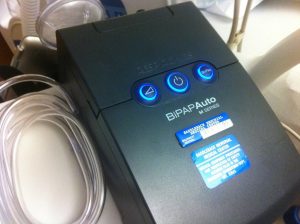Checking to See if NIV is Working
Similar to invasive ventilation, after choosing initial settings on a mode of ventilation, watch the patient’s breathing, oxygen status and tidal volume size. Small changes can be made in the first few breaths. One main difference with BiPAP versus invasive ventilation is the targeted tidal volume and RR.
Remember that NIV is used for patients that are conscious and have an intact drive to breathe. If they are tachypneic on BiPAP, this is not necessarily a sign of failure. As long as you are supporting adequate tidal volumes, let the patient breathe at whatever rate they want. Do not sedate them or give them sedation of any kind. This action can decrease their level of consciousness and decrease their drive to breathe, essentially making them no longer a candidate for BiPAP. Also, you can allow the patients to breathe at slightly higher tidal volumes than when doing invasive ventilation, as the patient is pulling these volumes spontaneously and the risk of barotrauma/volutrauma is a lot lower when we are not pushing the volumes into the lungs without the patient actively being involved.
After approximately 30 minutes on your initial NIV settings, do an arterial blood gas (ABG) to assess if the therapy is working. As long as the ABGs are trending in the right direction (CO2 decreasing/oxygenation increasing), your treatment is a success! If the ABGs are still the same or getting worse (CO2s increasing/oxygenation decreasing), then the patient may need to be intubated and fully ventilated with a control mode of ventilation to correct their abnormal CO2/O2 levels.

Media Attributions
- Not a CPAP, a BiPAP Machine © Foodie in Disguise is licensed under a CC BY-NC-ND (Attribution NonCommercial NoDerivatives) license

